
The Ffestiniog Railway is a heritage railway based on 1 ft 11+1⁄2 in narrow-gauge, located in Gwynedd, Wales. It is a major tourist attraction located mainly within the Snowdonia National Park.
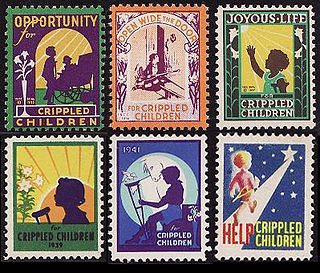
In philately, a cinderella stamp is a label that resembles a postage stamp, but which is not issued for postal purposes by a government administration. There is a wide variety of cinderella stamps, such as those printed for promotional use by businesses, churches, political or non-profit groups. The term excludes imprinted stamps on postal stationery.

The Welsh Highland Railway is a 25-mile (40.2 km) long, restored 1 ft 11+1⁄2 in narrow gauge heritage railway in the Welsh county of Gwynedd, operating from Caernarfon to Porthmadog, and passing through a number of popular tourist destinations including Beddgelert and the Aberglaslyn Pass. At Porthmadog it connects with the Ffestiniog Railway and to the short Welsh Highland Heritage Railway. In Porthmadog it uses the United Kingdom's only mixed gauge flat rail crossing.

Blaenau Ffestiniog railway station serves the slate mining town of Blaenau Ffestiniog, Wales, and is the passenger terminus of the Conwy Valley Line from Llandudno Junction. Transport for Wales Rail operate through services to Llandudno Junction and Llandudno. The station is a joint station with the narrow gauge Ffestiniog Railway, which operates primarily tourist passenger services to Porthmadog throughout most of the year. A feature of the standard gauge service is the availability on trains and buses of the popular "Gwynedd Red Rover" day ticket.
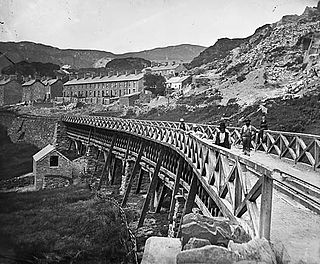
The Festiniog & Blaenau Railway (F&BR) was a narrow gauge railway built in 1868 to connect the town of Blaenau Ffestiniog in Wales with the slate quarries around Tanymanod and the village of Llan Ffestiniog, 3+1⁄2 miles (5.6 km) to the south. At Blaenau Ffestiniog it made a direct connection with the Festiniog Railway (FR) with which it was closely associated during its fifteen-year life. The railway was purchased by the Bala and Festiniog Railway in 1883 and converted to 4 ft 8+1⁄2 instandard gauge to extend the Bala Ffestiniog line, a branch of the GWR's line from Ruabon to Barmouth.
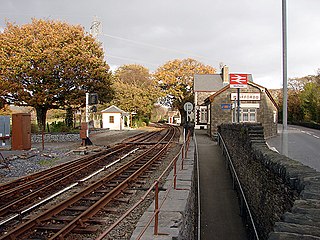
Minffordd railway station is a pair of adjacent stations on separate lines in Gwynedd, Wales. The mainline station opened as Minfford Junction on 1 August 1872 at the point where the then recently built Aberystwith and Welsh Coast Railway line from Dovey Junction to Pwllheli passes under the earlier narrow gauge Ffestiniog Railway. The latter was built in 1836 to carry dressed slate from Blaenau Ffestiniog to Porthmadog for export by sea, and had carried passengers from 1865 onwards. The station was renamed Minffordd in 1890.

Porthmadog Harbour railway station in Porthmadog, Gwynedd, North Wales. It is the passenger terminus of two narrow gauge railways: the Ffestiniog Railway, which was opened in 1836 to carry dressed slate from the Quarries around Blaenau Ffestiniog to the sea port of Porthmadog, for export by sea; and the Welsh Highland Railway, incorporated in 1923, which ran to Dinas. After rebuilding in 1997-2011, the other terminus is at Caernarfon, in sight of the Castle.
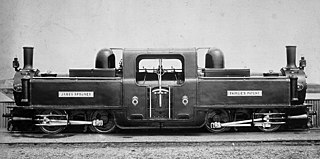
The Spooners of Porthmadog refers to the Spooner family of Porthmadog, North Wales who made important contributions to the development of narrow gauge railways both locally and throughout the world. James Spooner, together with his sons James Swinton and Charles Easton and other members of their family, constructed and managed the Ffestiniog Railway for over fifty years. In North Wales they were involved in the promotion of numerous railway schemes including many quarry lines, the Talyllyn Railway, the Festiniog and Blaenau Railway, the North Wales Narrow Gauge Railways and the Carnarvonshire Railway. Through publications and overseas family commissions they influenced narrow gauge railway construction in Russia, America and throughout the British Empire.

Tan-y-Manod railway station was a railway station approximately 1 mile (1.6 km) south of Blaenau Ffestiniog, in Gwynedd, North Wales.

The Welsh Highland Heritage Railway is a short reconstructed heritage railway in Gwynedd, Wales. Its main station is in Porthmadog.

In philately a railway stamp is a stamp issued to pay the cost of the conveyance of a letter or parcel by rail.
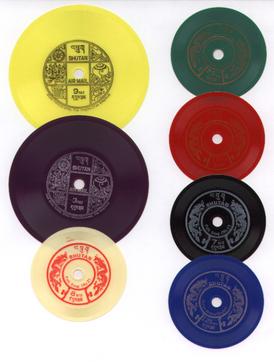
The first postage stamps of Bhutan were issued in 1962, the same year that the first motorable road was opened. Before that there was a mail delivery system in place for official mail using mail runners, and between 1955 and 1962 revenue stamps were accepted as payment for internal mail. With the opening up of Bhutan in the early 1960s, a formal postal system was introduced.
Ffestiniog Travel was established in 1974. It is a sister company to the Ffestiniog Railway (FR), both organisations being owned by the Ffestiniog & Welsh Highland Railways Trust which is a registered charity. Profits go to support the preservation of the FR and Welsh Highland Railway (WHR).
Allan George Weldon Garraway was a British railway manager, responsible for restoring the abandoned Ffestiniog Railway in the 1950s. He was awarded an MBE in 1983.
Tyddyngwyn railway station was immediately north of the later Manod station in what was then Merionethshire, now Gwynedd, Wales.

Duffws was the Festiniog Railway's (FR) second passenger station in Blaenau Ffestiniog, then in Merionethshire, now in Gwynedd, Wales. This station is not to be confused with the Festiniog and Blaenau Railway's (F&BR) Duffws (F&BR) station which stood some distance away on the opposite side of Church Street. During that station's life from 1868 to 1883 passengers travelling from (say) Festiniog on the F&BR to Tan-y-Bwlch on the Festiniog would walk between the two stations, much as passengers walk between the standard gauge and narrow gauge in modern-day Blaenau Ffestiniog.
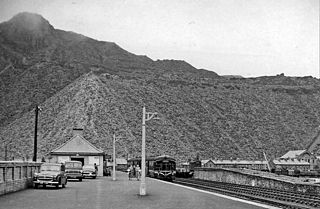
Blaenau Ffestiniog North was the London and North Western Railway's (LNWR's) second passenger station in Blaenau Ffestiniog, then in Merionethshire, now in Gwynedd, Wales.

On 10 September 1883, the Bala and Festiniog Railway (B&FR) and the Festiniog Railway (FR) opened what would be known as an interchange station in Blaenau Ffestiniog, Merionethshire, Wales. Merionethshire is now part of the county of Gwynedd.

North west Wales experienced a slate boom in the first half of the nineteenth century. Three sites stood out as experiencing the most explosive growth: Dinorwic near Llanberis, Penrhyn near Bethesda and Blaenau Ffestiniog.
Diphwys railway station was on the same site as the later Great Western Railway station in the heart of Blaenau Ffestiniog in what was then Merionethshire, now Gwynedd, Wales.















